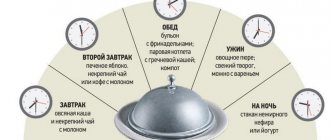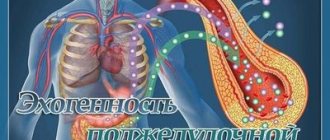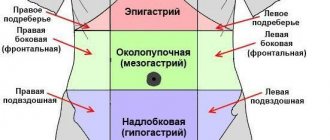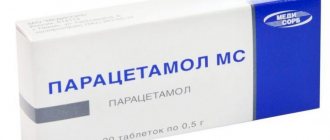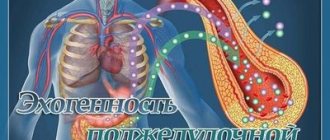The diagnosis of “gastritis” does not mean a separate disease, but a condition that is characterized by a whole complex of various pathological processes in the stomach. There are several types of gastritis, among which gastritis with low and high acidity is classified according to the acidity of the stomach.
If the doctor makes o when making a diagnosis, this means that the body has a high level of hydrochloric acid, which is part of the gastric juice. The danger of this condition is that an excessive amount of this aggressive substance can become a damaging factor, leading to the rapid progression of gastritis.
Causes
External reasons:
- malnutrition (dry food, snacks, poor chewing of food contribute to the appearance of mechanical injuries to the gastric mucosa, excessive consumption of salty and spicy foods contributes to irritation of the mucous membrane, too cold or hot food - thermal damage to the mucous membrane);
- damage to the stomach by Helicobacter pylori and other bacteria and fungi;
- foreign bodies entering the stomach;
- smoking and excessive drinking (which release caustic chemicals into the stomach);
- long-term use of medications (in particular glucocorticoid hormones, acetylsalicylic acid, NSAIDs, iron supplements, etc.);
- exposure to radiation on the mucous membrane;
- contact with mucous membranes of alkalis, acids and other toxic substances;
- parasitic infestations;
- chronic stress (acute stress gastritis can be a consequence of a serious illness, injury, life-threatening conditions, etc.).
Internal reasons:
- genetic predisposition (presence of gastritis in close relatives);
- duodenogastric reflux (reflux of fluid from the duodenum into the stomach);
- autoimmune processes that damage stomach cells;
- chronic infectious diseases (including salmonellosis, coronavirus, rotavirus infections, etc.);
- metabolic disorders;
- endocrine disorders;
- lack of vitamins, etc.
Diagnostics
The following laboratory and instrumental research methods are used for diagnosis:
- pH-metry – determination of acidity directly in the stomach cavity;
- gastric intubation with sampling of gastric juice - a tube is inserted into the stomach through which a portion of gastric juice is taken, then the concentration of hydrochloric acid in it is determined in the laboratory;
- fibroesophagogastroduodenoscopy (FEGDS) - using a fiber optic tube with lighting and a camera, you can directly see the condition of its mucous membrane.
When the first symptoms of gastritis appear, you should consult a gastroenterologist for additional examination and adequate treatment.
Symptoms
- Pain syndrome: aching or paroxysmal pain in the stomach (epigastric zone), in the left hypochondrium, often at night or during long breaks between meals.
- Heartburn is the most characteristic symptom of gastritis with increased stomach acidity.
- Sour belching is a sign of increased stomach acidity (with low acidity, belching with an unpleasant “rotten” smell is observed, since food is poorly digested).
- Nausea (most often on an empty stomach, after long breaks between meals).
- Vomiting (often after a person has eaten a lot of acidic foods).
- Bloating.
- Constipation (with hyperacid gastritis).
- Increased or decreased appetite.
If a person suffers from chronic gastritis with high acidity, the symptoms are not pronounced and appear only when exposed to provoking factors:
- overeating;
- long break between meals;
- alcohol, smoking;
- severe stress;
- too spicy, fatty, hot or cold food.
Symptoms of type A gastritis
The disease is asymptomatic until the development of intestinal megaloblastic anemia. In some cases it is characterized by:
- dull pain;
- heaviness after eating;
- unpleasant taste in the mouth;
- nausea, belching;
- flatulence, diarrhea.
Subsequently, a burning sensation of the tongue, drowsiness, fatigue, and numbness of the limbs appear. Objectively characterized by pallor of the skin, varnished surface of the tongue, loss of vibration sensitivity, gait disturbance, etc.
Treatment
Drug therapy
With increased or preserved secretion of gastric juice, enveloping, adsorbent agents and antacids are prescribed. Your doctor may prescribe calcium carbonate or bismuth nitrate, which have astringent properties. Antispasmodics are used to relieve pain. Improvement of digestive processes is achieved with the help of injections of aloe and vitamins.
Diet
Treatment of gastritis with high acidity should be accompanied by a diet called “Table No. 1”, which does not include foods that increase the production of hydrochloric acid (smoked meats, spices, marinades, fried foods, etc.). It is necessary to stop smoking and drinking alcohol and caffeine.
To make an appointment at the ABC-Medicine clinic for the diagnosis of gastritis, call +7 (495) 223-38-83.
Stomach acidity
The acid produced in the stomach is necessary for the digestion of food, for the absorption of iron, calcium, vitamin B12 and certain medications (for example, thyroxine and ketoconazole). Due to the high acidity of gastric juice, swallowed microorganisms, including bacteria and viruses, are destroyed. This prevents the development of infection and excessive growth of bacteria in the small intestine.
However, excessively high levels of acid secretion pose a risk to the integrity of the gastric and duodenal mucosa. Therefore, the secretion of gastric acid must be precisely regulated and produced according to needs.
Acid is produced by the parietal cells of the stomach. Their work is tightly controlled by numerous mechanisms, including the vagus nerve, gastrin, histamine, ghrelin, somatostatin, and glucagon-like peptide. Thanks to all these mechanisms (some of which are still not fully understood), the correct secretion of hydrochloric acid is ensured.
We wrote about reduced stomach acidity in a previous article:
Now we will talk about increased stomach acidity.
There are several reasons for increased stomach acidity:
- The most significant and dangerous reason is a tumor that produces gastrin in huge quantities. Gastrin is the main stimulator of hydrochloric acid secretion, so its production increases many times.
- Helicobacter pylori infection. In some patients infected with this bacterium, the secretion of hydrochloric acid increases.
- Taking painkillers, aspirin. These drugs reduce the production of bicarbonates - bicarbonates alkalize (make less acidic) the contents in the outlet of the stomach and duodenum.
- Increased production of hydrochloric acid for unknown reasons (probably congenital). As we have already discussed, the process of regulating its formation is complex; at what stage the “breakdown” occurs is not known; literature data on this topic is scarce and very outdated. As a rule, this increase is not so significant and if the patient is not bothered by it in any way, then this situation does not require diagnosis and treatment.
So, why is high stomach acid dangerous and why do we need this information at all?
Manifestations of increased stomach acidity may include the following:
- Heartburn. However, you need to understand that in most cases, heartburn occurs due to excessively frequent and prolonged reflux of stomach acid into the esophagus. The mechanism here is multicomponent and often the problem is not so much the level of acidity as the very fact of the stomach contents entering the esophagus. Even if the acidity level of the stomach is normal, this is enough to “burn” the esophagus. For heartburn, it is not recommended to determine the level of acidity in the stomach, since this information will not affect treatment tactics (not to be confused with determining acidity in the ESOPHAGUS, which in certain cases is necessary to select a treatment method!).
- Formation of ulcers in the stomach.
In 1910, the concept was recognized: “No acid, no ulcer.” In 1984, after the discovery of the role of H. pylori, the concept was radically changed: “No H. pylori - no ulcer.”
Yes, if the secretion of hydrochloric acid is increased many times (as in gastronomy - Solinger-Ellison syndrome), then ulcers actually form in the stomach and duodenum, and can even be in the esophagus and the initial part of the jejunum).
If the formation of gastric juice is not increased as significantly as in Solinger-Ellison syndrome, then, as a rule, acid alone is not enough to form ulcers - the presence of Helicobacter pylori infection and/or taking painkillers, aspirin is necessary.
For ulcers, the standards include diagnosis and treatment of Helicobacter (about 90% of all ulcers are associated with it), determination of gastrin levels (only if gastrinoma is suspected) and discontinuation of painkillers/aspirin if the patient was taking them (if cancellation is not possible, medications are prescribed for stomach protection). The standards do not include determining the level of acidity , since its moderate increase will not affect the treatment tactics (an exception may be the suspicion of the absence or sharp decrease in the production of hydrochloric acid by the stomach - here the determination of acidity can be useful and will affect the treatment tactics).
- Epigastric pain not associated with the formation of ulcers. The diagnosis sounds like functional dyspepsia (formerly chronic gastritis). Yes, indeed, approximately 20-25% of patients with functional dyspepsia have increased acidity of gastric juice. However, patients with dyspepsia in most cases benefit from treatment with drugs that reduce acidity, regardless of whether it was initially elevated or not (there is no exact correlation between the level of response to treatment and the level of acidity before treatment), so there is little point in defining it. And if the symptoms are eliminated, then further reducing acidity is pointless and unsafe.
Let's summarize the above: usually it is not too important for us to know that the patient's acidity is increased (with the exception of gastrinoma, and this is very rare), since this will not affect the treatment tactics:
- have an ulcer - we treat Helicobacter
- there is pain without an ulcer - we are treated according to the dyspepsia protocol
- there is heartburn - we modify the diet and weight, treat with drugs that reduce acidity (even if it is normal)
In clinical practice, the Gastropanel blood test is usually used to diagnose acidity levels ; in rare cases (usually as part of clinical studies), gastric pH-metry .
In most cases, the level of acid secretion is determined if there is a suspicion of a decrease in the level of its production, the cause of which is gastric atrophy. This really matters for the choice of treatment tactics and monitoring of the patient. Therefore, in Western countries, the Gastropanel blood test is used everywhere and is carried out by general practitioners to decide on the need for further FGDS and consultation with a gastroenterologist. Decisive is the presence of signs of Helicobacter pylori infection (analysis is included in the Gastropanel), signs of atrophy, signs of gastrinoma.
If a person has symptoms of functional dyspepsia (pain, burning, feeling of fullness and heaviness in the epigastrium) and heartburn, then he really has a subjective feeling that “too much acid is being produced” and this may be partly true (but as we discussed earlier - perhaps it’s not just the excess acid or not at all), so the diet can have a positive effect. It's no secret that certain foods stimulate the production of hydrochloric acid more strongly. Therefore, the first thing to do in case of the symptoms described above is to reconsider your eating habits - eat regularly, try to limit too sour, spicy, smoked, fried foods, as well as coffee, alcohol and fast food in your diet. But we remember that food should be tasty and nutritious - eating just chicken breast with buckwheat is also not an option. Diets that are too strict can do more harm than good and make the situation worse.
If changing your diet does not help, you should definitely consult a doctor to receive adequate examination and treatment.
Folk recipes
In the treatment of gastritis with high acidity, in addition to diet and medications, traditional herbal decoctions and infusions are often used, which have proven themselves to be excellent.
- Honey to reduce stomach acidity. Dissolve honey in warm water - it is known that a warm solution of honey perfectly reduces the acidity of the stomach, is quickly absorbed in the stomach and does not irritate the gastric mucosa. During the day you need to drink approximately 150 g of honey solution. Take for one and a half to two months.
- Freshly squeezed juice from raw potatoes. In the treatment of gastritis with high acidity, fresh raw potato juice has proven itself very well. If the doctor has not given any other recommendations, then in the morning you should drink ¾ glass of freshly squeezed raw potato juice on an empty stomach. After taking the juice, you should lie down for about half an hour. You can have breakfast in an hour. The duration of treatment is ten days. The course can be repeated up to three times, taking a break of ten days between courses.
- Carrot juice. Carrot juice has been successfully used to reduce stomach acidity. To prepare juice, you should choose only fully ripened root vegetables rich in carotene and sugars. Freshly squeezed carrot juice should be taken half a glass an hour before meals (one dose per day). After ten days of taking it, take a ten-day break, then repeat the course.
A complex herbal mixture to reduce stomach acidity. You will need:
- Plant raw materials plantain leaves - 8 tablespoons;
- Vegetable raw materials of cudweed herb - 8 tablespoons;
- Plant raw materials St. John's wort herb - 8 tablespoons;
- Plant material of centaury herb - 4 tablespoons;
- Plant raw materials mint leaves - 2 tablespoons;
- Plant material of knotweed herb - 4 tablespoons;
- Vegetable raw material calamus rhizome - 2 tablespoons;
- Cumin fruits - 3 tablespoons;
- Plant raw materials of yarrow herb - 1 tablespoon;
- Boiling water - 1000 g.
Mix all plant materials thoroughly. In an enamel or glass container, pour two tablespoons of the prepared mixture with boiling water and leave for 12 hours. Strain. Take half a glass after meals four times a day.
Menu for the week
The diet used for stomach acidity is based on food that is gentle on the functions of the gastrointestinal tract. During such a diet, fatty and spicy foods, sausages, pickles, marinades, carbonated drinks, and fast foods are excluded from consumption. The basis of the diet consists of foods that reduce acidity levels.
Day 1−2:
- Breakfast: ground buckwheat porridge (with milk), cottage cheese soufflé, herbal tea.
- Lunch: soft-boiled egg, vegetables.
- Lunch: light vegetable soup, meatballs, carrot puree, jelly.
- Dinner: fish cutlets, pasta.
- Before bed: milk or kefir.
Day 3−4:
- Breakfast: oatmeal, carrot puree, tea.
- Lunch: pancakes.
- Lunch: zucchini soup, steamed cutlets, pasta, compote.
- Dinner: lazy dumplings, plum soufflé.
- Before bed: milk or kefir.
Day 5−6:
- Breakfast: baked omelette, avocado toast, tea.
- Lunch: carrot-apple soufflé.
- Lunch: rice soup (milk-based), boiled meat, jelly.
- Dinner: mashed potatoes, a little spinach, low-fat cottage cheese.
- Before bed: milk or kefir.
Day 7:
- Breakfast: semolina porridge, dry cookies, tea with milk.
- Lunch: egg soufflé.
- Lunch: chicken soup with croutons, baked apples with honey, fresh vegetable salad, dried fruit compote.
- Dinner: baked chicken with rice, boiled potatoes, stewed vegetables.
- Before bed: milk or kefir.
Don't go to bed on a full stomach. Lying down immediately after eating can cause stomach acid to move back up the tract instead of down. As a result, this only contributes to the stimulation of an increase in acidity levels.
Pathogenesis
Normally, the gastric mucosa has a powerful protective system that protects it from exposure to the aggressive gastric environment. However, under the influence of certain factors, protective barriers can be weakened, creating favorable conditions for the inflammatory process. These factors include: constant physical and moral fatigue, various occupational hazards, hereditary characteristics of the body, weakening of the body against the background of severe concomitant diseases.
Consequences
Due to the excess hydrochloric acid content in the stomach and the resulting indigestion, the patient may experience a sharp loss of body weight. A deficiency of nutrients, vitamins and minerals leads to brittle hair and nails, deterioration in the appearance of the skin - it becomes gray, dull, dehydrated, loses tone and becomes vulnerable to mites. Teeth are also subject to negative effects.
A more serious complication of increased gastric pH is the occurrence of gastritis and peptic ulcers. However, the development of these diseases most often requires the presence of additional negative factors (Helicobacter pylori infection, unhealthy lifestyle, unhealthy diet).
Opportunities for quickly eliminating symptoms and normalizing the level of stomach acidity allow us to make favorable prognoses for patients who are attentive to their health and follow the doctor’s recommendations.
Diet and nutrition rules
For gastritis with high acidity, the patient must follow certain dietary rules:
- Method of preparation: boiling (preferably steamed) baking without crust.
- The food should be warm. Hot and cold foods are prohibited.
- Don't overeat. The portion should be small.
- You need to eat 5-6 times a day at regular intervals.
- It is necessary to exclude from the diet: salty, spicy, fatty foods, sour fruits, rich broths.
- Dishes are consumed pureed or chopped. Boiled fish or lean meat can be served in pieces.
Advice: if the disease worsens, you will have to eat porridge with water and rice water. As the condition improves, the remaining dishes are gradually introduced.
You can eat:
- vegetable soups and puree soups;
- boiled or baked lean meats and fish;
- porridge: buckwheat, semolina, oatmeal;
- milk soups;
- vermicelli, pasta;
- jelly, compotes and jelly from sweet fruits with sugar;
- non-acidic kefir and yogurt;
- steam omelettes, soft-boiled eggs;
- vegetable oils;
- herbs;
- mild cheese;
- milk;
- cream.
We exclude:
- fresh (especially sour) fruits and berries;
- sour juices;
- spicy dishes;
- meat and mushroom broths;
- legumes;
- porridge: corn, millet, barley;
- borscht;
- okroshka;
- pastry products;
- sausages;
- varieties of fish and meat with high fat content;
- canned food;
- cabbage;
- radish;
- pickled and pickled vegetables;
- fresh bread.
It is worth noting that the diet for erosive gastritis of the stomach, reflux gastritis or gastroduodenitis (as well as for other types of gastrointestinal diseases associated with high acidity) excludes the consumption of any fast food. This group of food products also includes muesli, which is often mistakenly classified as a healthy diet, and hot dogs, pizzas and burgers, loved by many, even those cooked at home.

